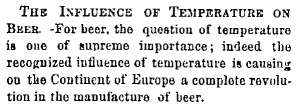
Almost exclusively, Czech brewing means lagers, beers produced with bottom-fermenting lager yeasts at colder temperatures and over longer periods of time. Today, some 95% of Czech production is composed of golden lagers, while about 5% is dark lager. The few beers made with top-fermenting yeasts — ales and wheat beers, brewed at warmer temperatures and usually over shorter periods of time — now make up less than one half of one percent of Czech production. And yet just a little over 140 years ago, ales and wheat beers were still the standard here.
But then came a change in Czech brewing which was so sudden and so severe that it counted as news even on the other side of the world. An article in the New York Times of December 3, 1876, detailed the “complete revolution” in brewing that was then taking place in Bohemia, the western half of today’s Czech Republic, noting the shift away from what it calls “high fermentation” breweries (meaning ales) to the new, “low fermentation” breweries (producing lagers). As the article shows, the arrival of lagers was swift and merciless, killing off more than 260 ale breweries between 1860 and 1870 in Bohemia alone.



